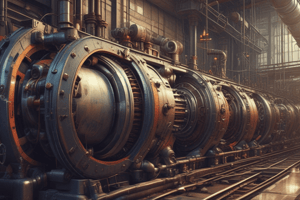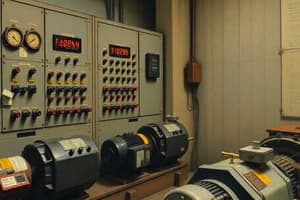Podcast
Questions and Answers
Which safety measure is MOST effective in preventing electrical shocks to personnel working with motor control systems?
Which safety measure is MOST effective in preventing electrical shocks to personnel working with motor control systems?
- Selecting appropriate enclosure types based on the industrial setting.
- Utilizing emergency stop systems for immediate motor shutdown.
- Implementing overload protection using thermal overload relays.
- Ensuring proper grounding of all electrical components and equipment. (correct)
In an industrial setting, what is the PRIMARY benefit of using predictive maintenance with motor control systems?
In an industrial setting, what is the PRIMARY benefit of using predictive maintenance with motor control systems?
- Ensuring compliance with energy efficiency standards.
- Optimizing load characteristics to improve motor performance.
- Reducing the initial cost of motor control system components.
- Identifying potential motor failures before they occur, ensuring reliability. (correct)
When selecting a motor for a high-precision robotic assembly line, which motor type is MOST suitable if precise positioning and holding torque are critical?
When selecting a motor for a high-precision robotic assembly line, which motor type is MOST suitable if precise positioning and holding torque are critical?
- AC induction motor
- Linear motor
- Stepper motor (correct)
- DC brushed motor
How do optimized motor control strategies contribute to the reduction of energy consumption?
How do optimized motor control strategies contribute to the reduction of energy consumption?
In the context of motor control systems applied to HVAC, what is the PRIMARY advantage of regulating fan speed?
In the context of motor control systems applied to HVAC, what is the PRIMARY advantage of regulating fan speed?
Which of the following characteristics is NOT typically associated with AC induction motors in industrial applications?
Which of the following characteristics is NOT typically associated with AC induction motors in industrial applications?
In applications requiring precise speed control and high starting torque, which type of motor is MOST suitable?
In applications requiring precise speed control and high starting torque, which type of motor is MOST suitable?
Which control component is MOST effective in optimizing the energy efficiency of an AC motor by adjusting the frequency and voltage supplied to the motor?
Which control component is MOST effective in optimizing the energy efficiency of an AC motor by adjusting the frequency and voltage supplied to the motor?
In a motor control system, what is the PRIMARY function of sensors?
In a motor control system, what is the PRIMARY function of sensors?
Which type of motor starter applies the full line voltage directly to the motor terminals?
Which type of motor starter applies the full line voltage directly to the motor terminals?
Which of the following is a PRIMARY advantage of using a soft starter over a direct-on-line (DOL) starter for an AC motor?
Which of the following is a PRIMARY advantage of using a soft starter over a direct-on-line (DOL) starter for an AC motor?
Which control strategy is MOST appropriate for achieving precise positioning and incremental movement in robotic systems?
Which control strategy is MOST appropriate for achieving precise positioning and incremental movement in robotic systems?
In sensor-based control systems, what is the PRIMARY reason for using feedback from sensors?
In sensor-based control systems, what is the PRIMARY reason for using feedback from sensors?
Flashcards
Overload protection
Overload protection
Components that prevent motor or control system damage, including thermal overload relays and current sensors.
Grounding
Grounding
A safety measure to prevent electrical shocks and ensure safety for personnel and equipment.
Emergency stop systems
Emergency stop systems
Systems designed for immediate motor shutdown during emergencies or malfunctions.
Energy efficiency standards
Energy efficiency standards
Signup and view all the flashcards
Predictive maintenance
Predictive maintenance
Signup and view all the flashcards
Industrial Motor Control
Industrial Motor Control
Signup and view all the flashcards
AC Motors
AC Motors
Signup and view all the flashcards
DC Motors
DC Motors
Signup and view all the flashcards
Stepper Motors
Stepper Motors
Signup and view all the flashcards
Motor Starters
Motor Starters
Signup and view all the flashcards
Variable Frequency Drives (VFDs)
Variable Frequency Drives (VFDs)
Signup and view all the flashcards
Programmable Logic Controllers (PLCs)
Programmable Logic Controllers (PLCs)
Signup and view all the flashcards
Sensor-Based Control
Sensor-Based Control
Signup and view all the flashcards
Study Notes
Introduction to Industrial Motor Control
- Industrial motor control systems regulate electric motor operation in industrial settings.
- Precise speed, torque, and direction control maximize efficiency and safety.
- Motor control uses various components: the motor itself, control devices, and protective equipment.
- Specific control strategies are needed for different motor types, considering load characteristics and desired performance.
Types of Industrial Motors
- AC (Induction) motors are widely used for their robustness, cost-effectiveness, and ease of maintenance.
- DC motors (Brushed or Brushless) are preferred for applications needing precise speed control or high starting torque; Brushless DC motors excel in efficiency and reduced maintenance.
- Stepper motors are ideal for precise positioning and incremental movement, such as in robotic systems.
- Linear motors are designed for linear motion applications, featuring high power density, useful in conveyor belts and automated machinery.
Control Components
- Motor starters control motor start/stop, protecting the motor and connected systems. Types include direct-on-line, star-delta, and soft starters.
- Variable frequency drives (VFDs) adjust AC motor speed and torque by changing input voltage frequency, enhancing efficiency and optimizing motor operation.
- Programmable logic controllers (PLCs) are central control units that interpret sensor signals, make decisions based on programmed logic, and control motor operations.
- Sensors provide feedback on motor performance (current, speed, temperature), allowing dynamic adjustments to motor operation.
- Relays and contactors are switching devices controlling power to the motor and other components, ensuring safe and reliable operation.
Control Strategies
- DC Motor Control involves armature voltage and field control techniques.
- AC Motor Control uses voltage-source inverters, current-source inverters, and VFDs.
- Stepper Motor Control precisely sequences pulses to achieve desired positions and motions.
- Sensor-Based Control integrates sensor feedback and control algorithms for complex, accurate, and efficient control tasks.
Safety Considerations
- Overload protection prevents motor and system damage via thermal overload relays and current sensors.
- Grounding is crucial to prevent electrical shocks and ensure personnel and equipment safety.
- Emergency stop systems halt the motor immediately in case of emergency or malfunction.
- Different enclosure types enhance safety in various industrial environments, balancing safety with accessibility.
Efficiency and Optimization
- Energy efficiency standards reduce energy consumption with optimal control strategies.
- Motor selection considers the motor type for specific application requirements (AC, DC, stepper, linear).
- Load management optimizes load characteristics to maximize motor performance.
- Predictive maintenance, using sensors and data analysis, identifies potential issues before failure, ensuring reliability and efficiency.
Applications
- Manufacturing uses motors in assembly lines, robotic systems, material handling, and machine tools.
- Heavy machinery utilizes motors in cranes, pumps, and compressors.
- HVAC systems regulate fan speed and climate control energy efficiency.
- Transportation involves controlling electric vehicles and other transportation equipment.
- Renewable energy systems use motors in wind turbines, solar panels, and other renewable energy sources.
Studying That Suits You
Use AI to generate personalized quizzes and flashcards to suit your learning preferences.





